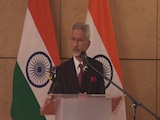- L 98-59 system hosts a newly confirmed fifth planet in its habitable zone
- The planet has a minimum mass 2.8 times that of Earth and is classified as a super-Earth
- The planet orbits a red dwarf star 35 light-years from Earth in an almost circular orbit
A team of scientists has studied the L 98-59 planetary system and confirmed the existence of a fifth planet, named L 98-59 f, in the star's habitable zone. The zone has conditions that could allow liquid water to exist.
L 98-59 is a small red dwarf located just 35 light-years from Earth. In 2019, NASA's TESS space telescope found that it hosts three small transiting exoplanets. A fourth planet was revealed through radial velocity measurements with the European Southern Observatory's ESPRESSO spectrograph.
Now, the team led by the Trottier Institute for Research on Exoplanets (IREx) at the Universite de Montreal has found a fifth one in the system.
Also Read | NASA Reveals How It Fixed A Camera 370-Million-Miles Away In Deep Space
"These new results paint the most complete picture we've ever had of the fascinating L 98-59 system," said Cadieux in the press release. "It's a powerful demonstration of what we can achieve by combining data from space telescopes and high-precision instruments on Earth, and it gives us key targets for future atmospheric studies with the James Webb Space Telescope [JWST]."
The exoplanet has a minimum mass 2.8 times that of Earth and has been categorised as a super-Earth. L 98-59 f follows an almost perfectly circular orbit around its star, receiving roughly the same amount of stellar energy as Earth.
Its location in the habitable zone suggests that liquid water could exist on its surface under suitable atmospheric conditions, making it a potential candidate to support life.
If L 98-59 f has an atmosphere, telescopes like the James Webb Space Telescope (JWST) may be able to detect water vapour, carbon dioxide or even biosignatures.
Also Read | Scientists Find Mysterious Object In Kuiper Belt, And It's Not A Planet
Cadieux said that the discovery highlights the "diversity of exoplanetary systems" and also "strengthens the case for studying potentially habitable worlds around low-mass stars".
"With its diversity of rocky worlds and range of planetary compositions, L 98-59 offers a unique laboratory to address some of the field's most pressing questions: What are super-Earths and sub-Neptunes made of? Do planets form differently around small stars? Can rocky planets around red dwarfs retain atmospheres over time?" René Doyon, co-author of the study, who is a professor at UdeM and the Director of IREx, said.
The findings are reported in research that will appear in The Astronomical Journal titled "Detailed Architecture of the L 98-59 System and Confirmation of a Fifth Planet in the Habitable Zone."














